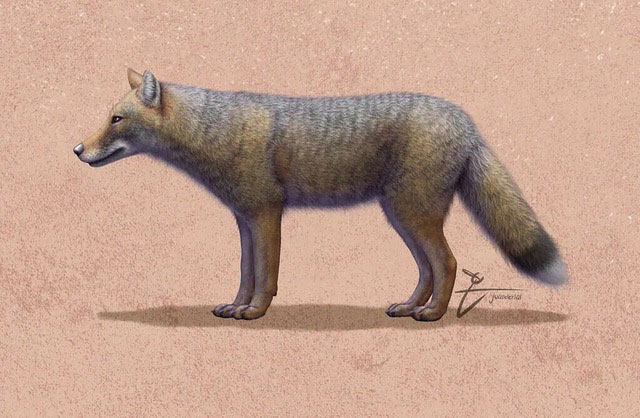Ancient foxes were domesticated and kept as pets 1,500 years ago
New archaeological discoveries reveal a companionship between humans and foxes in South America , and it could change our understanding of early animal domestication.
Dogs are considered the first animals domesticated by humans, and the strong bond between dogs and humans has existed for thousands of years. However, dogs are not the only canine species that ancient people kept as pets.
A remarkable archaeological study in South America found fox remains next to human graves from 1,500 years ago. Genetic evidence shows that this fox ate a diet similar to that of hunter-gatherers in Patagonia.
Dr Ophélie Lebrasseur of the University of Oxford said: "This is a very rare finding as this fox appears to have such a close relationship with individuals in hunter-gatherer societies."

The Dusicyon avus fox, also known as Darwin's fox , lived in Patagonia, South America until about 1,000 years ago. Scientists have discovered evidence that the fox was domesticated by hunter-gatherers in the area 1,500 years ago.
Examination of the teeth showed that this ancient domesticated fox belonged to the Dusicyon avus fox, an extinct species that resembles a jackal. It is about the size of a German shepherd and is closely related to the Falkland Islands wolf (Dusicyon australis). The Falkland Islands wolf became extinct in 1867.
The researchers took small samples from the animal's forearms and vertebrae for DNA analysis. Although the genetic samples were severely degraded, scientists were still able to repair and recreate some of the missing gene sequences. As a result, scientists found no match between these foxes and any living canids.
This DNA data also refute previous views that ancient foxes interbred with domestic dogs that were brought to Patagonia about 1,000 years ago. However, Dusicyon avus is so genetically different from domestic dogs that they cannot produce hybrid offspring.
It is not known why Dusicyon avus became extinct. However, another mystery is why the remains of this fox-like creature were buried with humans.

The discovery was made at an archaeological site in the province of Santa Cruz, Argentina. Archaeologists have found the bones and teeth of Darwin's fox along with human bones and other artifacts. DNA analysis shows that this fox is not related to any living canids, whether domestic dogs or other South American foxes. This DNA data further strengthens the idea that these scratch remains belong to the species Dusicyon avus. It also refuted previous ideas that ancient foxes interbred with domestic dogs brought to Patagonia about 1,000 years ago.
Radiocarbon analysis of both fox and human remains showed they were of similar age. Likewise, both types of remains show similar wear patterns, suggesting that Dusicyon avus and humans were intentionally buried together.
Isotopes preserved in the teeth of Dusicyon avus hint at its diet. It contains meat, which is the main dish of any wild canid. However, its diet also included a corn-like plant - the same plant that the buried humans also ate.
The most plausible explanation seems to be that humans domesticated and raised Dusicyon avus as a companion. In fact, wild fox teeth have also been found in other ancient human burials in Argentina and Peru. Furthermore, archaeologists have previously found small ornaments made from the teeth of South American foxes.

Dusicyon avus is an extinct species of cerdocyonine canid of the genus Dusicyon , native to South America during the Pleistocene and Holocene. It is medium to large in size, about the size of a German shepherd. It is closely related to the Falkland Islands wolf, originating from the D. avus population. The range of Dusicyon avus extends across the Pampas and Patagonia in southern and central South America, with an estimated range of 762,351km².
This discovery is significant because it provides the first evidence that foxes were domesticated in South America. It also suggests that animal domestication may have occurred earlier and in more parts of the world than previously thought.
In addition, this discovery also shows that the relationship between humans and foxes is more complex than previously thought. It is possible that hunter-gatherers domesticated Darwin's fox as a pet, to help hunt or for fur.
Foxes are part of the dog family, Canidae, which also includes domestic dogs, wolves, jackals, dingoes and other canids. However, despite being in the same family, dogs (and wolves) are both in the genus Canis, while most foxes are in the genus Vulpes. There are about ten million years of evolution separating domestic dogs and red foxes.
- The ancient Chinese people raised rabbits as pets from 5,000 years ago
- Cats have been domesticated since ancient times
- The reason that pets often have reduced brain
- The discovery of foxes always carries a sad face
- Arctic fox - beautiful animals eat their own feces
- Fun fact interesting about foxes
- Found 5,600-year-old cat bones in Egypt
- Robots can replace pets in the future
- Close-up of ravishing red fox in white snow
- Thousands of foxes have been
- Controversy over the origin of domesticated horses
- Why do pets make us happier?
 Discovered an ancient centipede fossil 99 million years old
Discovered an ancient centipede fossil 99 million years old Discovered bat-like dinosaurs in China
Discovered bat-like dinosaurs in China Discovered a 200-year-old bronze cannon of the coast
Discovered a 200-year-old bronze cannon of the coast Discover 305 million-year-old spider fossils
Discover 305 million-year-old spider fossils